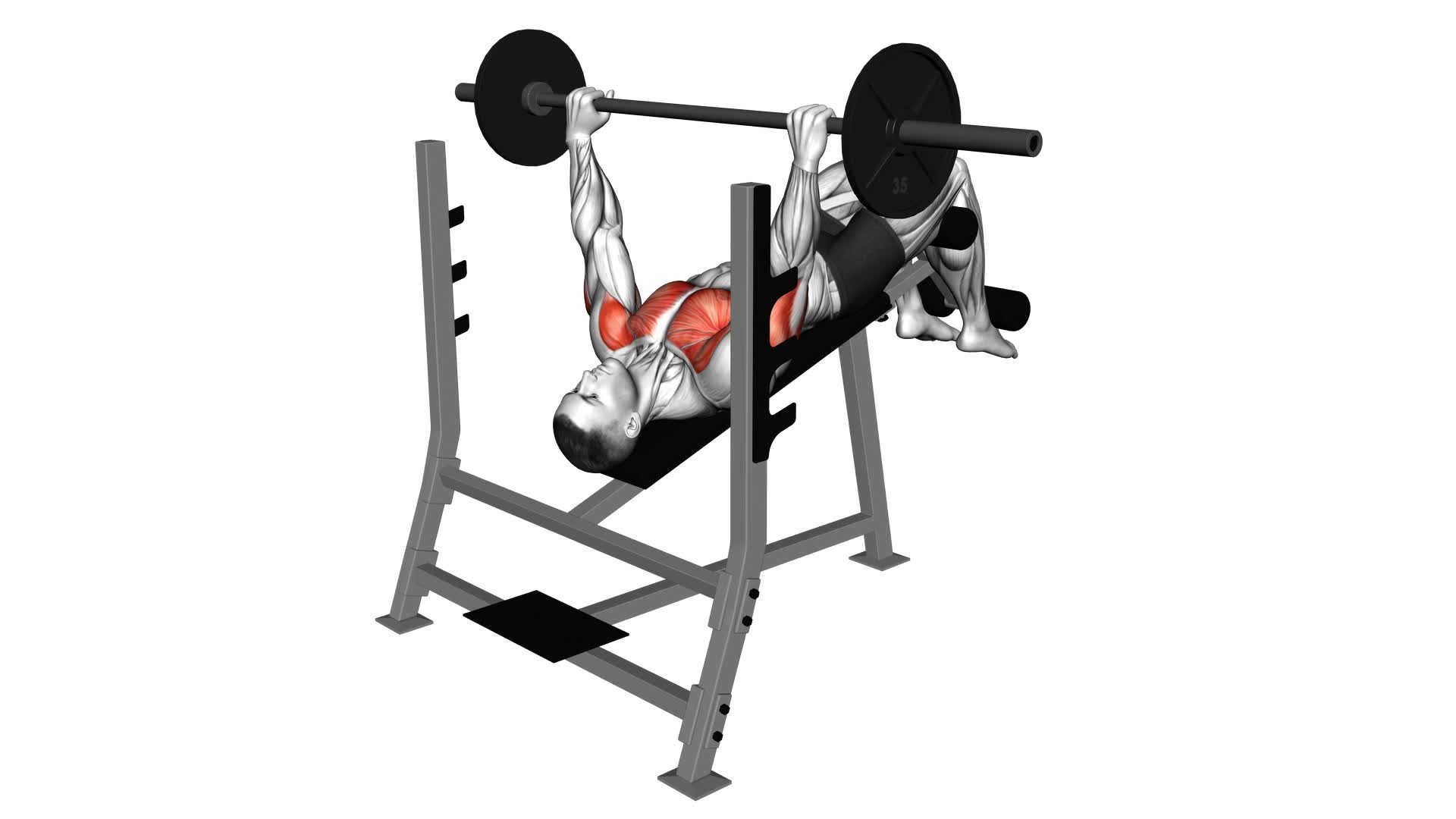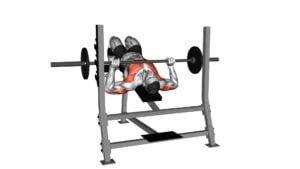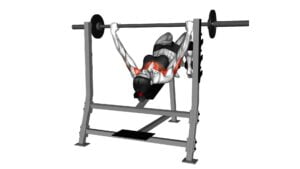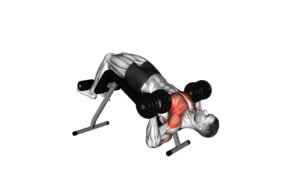Barbell Decline Bench Press – Video Exercise Guide & Tips

Struggling to get that chiseled chest definition from your current workout routine? The decline bench press, a lesser-known but highly effective exercise, targets the lower part of your pec muscles.
Watch This Exercise Video
This blog post will guide you step by step through the technique, form and benefits of this unique exercise with video illustrations. Stay tuned as we unveil the insider tips to maximize your results with the decline bench press!
Key Takeaways
- The decline bench press is a highly effective exercise for targeting the lower part of your chest muscles.
- It also engages other muscle groups like triceps, shoulders, and muscles beneath the shoulder blades.
- To perform a decline bench press correctly, lie down on a decline bench with feet secured, grab the barbell with an overhand grip, lower it towards your chest while keeping elbows tucked in, and push it back up by extending your arms fully.
- Tips for maximizing results include maintaining proper form and technique, varying grip width and hand placement to target different areas of your chest muscles, and gradually increasing weight as you get stronger.
Overview of Decline Bench Press
The decline bench press is a highly effective exercise that primarily targets the chest muscles while also engaging the shoulders and triceps.
Benefits for chest muscles
The decline bench press significantly develops the lower part of your pectoral muscles. By focusing on this often neglected area, you can enhance the overall appearance and strength of your chest.
This effective weightlifting exercise also promotes balance in muscle development between the upper and lower parts of your chest. Engaging these specific muscles leads to a stronger performance during other upper body workouts as well.
Muscles worked during exercise
The decline bench press primarily targets the lower chest muscles, known as the pectoralis major. This exercise also engages other muscle groups such as the triceps brachii (located at the back of the upper arm), anterior deltoids (front part of the shoulders), and serratus anterior (muscles beneath the shoulder blades).
By performing this exercise correctly, you can effectively strengthen and develop these muscles. Adding variation to your workout routine, like incline bench presses or dumbbell decline presses, can help target different areas of your chest and further enhance overall strength and muscle growth.
How to Perform a Decline Bench Press
To perform a decline bench press, lie down on a decline bench with your feet secured and grab the barbell with an overhand grip slightly wider than shoulder-width apart. Lower the barbell towards your chest while keeping your elbows tucked in, then push it back up to the starting position by extending your arms fully.
Proper form and technique
To perform the decline bench press with proper form and technique, lie down on the decline bench with your feet securely planted on the floor. Grip the barbell slightly wider than shoulder-width apart, keeping your wrists straight.
Lower the barbell to your mid-chest while maintaining control and a slow, controlled descent. Push the barbell back up until your arms are fully extended, keeping tension in your chest muscles throughout the movement.
Make sure to engage your core and maintain a stable position throughout. Avoid arching your back or using excessive momentum to lift the weight. Focus on squeezing your chest as you push the weight up for maximum muscle activation.
Tips for maximizing results
To maximize your results when performing the decline bench press, it’s important to focus on a few key tips. First, make sure to maintain proper form and technique throughout the exercise.
This includes keeping your back flat against the bench, lowering the barbell slowly and controlled, and pushing through your chest muscles to lift the weight. Additionally, vary your grip width and hand placement to target different areas of your chest muscles.
Experiment with both wider and narrower grips to challenge your muscles in different ways. Finally, don’t be afraid to increase the weight as you get stronger. Gradually challenging yourself with heavier weights will help build strength and muscle mass over time.
Video Exercise Guide for Decline Bench Press
This section provides a demonstration of the proper form and technique for performing the decline bench press, along with clear instructions for beginners.
Demonstration of proper form and technique
To ensure you perform the decline bench press correctly, it’s essential to focus on proper form and technique. The video exercise guide provides a visual demonstration of how to execute this exercise effectively.
Pay attention to key points such as maintaining a stable and controlled movement throughout the range of motion, keeping your feet firmly planted on the ground, gripping the barbell with a slightly wider than shoulder-width grip, and lowering the weight under control while engaging your chest muscles.
This demonstration will help you understand exactly how to perform the decline bench press with correct form for maximum effectiveness and reduced risk of injury.
Instructions for beginners
To perform a decline bench press correctly as a beginner, start by adjusting the decline bench to an angle of approximately 30 degrees. Lie back on the bench and position your feet securely under the foot pads or have someone hold them down for stability.
Grip the barbell slightly wider than shoulder-width apart with palms facing forward. Lower the barbell slowly towards your chest, keeping elbows tucked in at around a 45-degree angle.
Push the barbell back up to starting position by extending your arms fully without locking out your elbows. Remember to maintain control throughout the movement and breathe steadily.
Common Mistakes to Avoid
Some common mistakes to avoid during the decline bench press include not utilizing the full range of motion, using improper grip or bar placement, and using too much weight.
Not utilizing full range of motion
To get the most out of your decline bench press, it’s crucial to utilize the full range of motion. This means lowering the barbell all the way down until it touches your chest and then pushing it back up until your arms are fully extended.
Many people make the mistake of only going partially down or stopping short at the bottom, which limits their gains. By not using a full range of motion, you’re cheating yourself out of fully engaging your chest muscles and maximizing growth.
Remember to focus on achieving a complete and controlled movement with each repetition for optimal results in your decline bench press workout.
Improper grip or bar placement
To maximize your gains and minimize the risk of injury, it is crucial to have a proper grip and bar placement during the decline bench press. Firstly, make sure you grip the barbell with your hands slightly wider than shoulder-width apart.
This provides stability and allows for optimal control throughout the exercise. Secondly, ensure that you position the bar directly over your chest before unracking it. A common mistake is placing it too far up or down on the rack, which can throw off your form and decrease effectiveness.
By maintaining a correct grip and bar placement, you’ll be able to target your chest muscles more effectively while reducing strain on other areas of your body.
Using too much weight
Using too much weight during the decline bench press can lead to poor form and increase the risk of injury. It’s important to choose a weight that allows you to maintain proper technique throughout the exercise.
Overloading the barbell can cause your elbows to flare out, putting unnecessary stress on your shoulders and chest muscles. Additionally, using excessive weight can also prevent you from completing full range of motion, limiting the effectiveness of the exercise.
To avoid these issues, start with a lighter weight and gradually increase as you build strength and maintain control over each repetition.
Conclusion
In conclusion, the barbell decline bench press is a highly effective exercise for targeting and developing your chest muscles. By following proper form and technique, as well as incorporating the tips provided, you can maximize your results and achieve greater strength in this exercise.
Watch the video exercise guide to ensure you are performing it correctly and avoid common mistakes for optimal muscle building during your gym workouts.
FAQs
1. What is the Barbell Decline Bench Press technique?
The Barbell Decline Bench Press technique is a strength training exercise performed on an adjustable decline bench press machine, focusing primarily on chest development.
2. What are some benefits of the Dumbbell Decline Bench Press?
Benefits of the Dumbbell Decline Bench Press include increased upper body strength and muscle building, specifically targeting muscles in your lower chest area.
3. How does one maintain proper form during a decline bench press?
Maintaining proper form for decline bench press involves adjusting the decline bench to a comfortable angle, keeping your feet securely hooked onto footrests, ensuring full control over weights while pressing them upwards and following proper breathing techniques throughout.
4. Can you suggest other exercises that can be alternates for the Barbell Decline Bench Press?
Yes! Incline bench press or flat bench press with dumbbells or barbells can serve as good alternative exercises for those who find difficulty performing traditional Decline Bench presses.
5. Is there any precautionary measure while doing this workout?
To avoid common mistakes during this gym workout routine, it’s essential to follow fitness tips like using suitable weight levels and not locking out elbows entirely upon extending arms; practicing good posture by aligning wrists directly above elbows; and observing safety guidelines including having spotter assistance if needed.
6. Could anyone define what is differing between incline vs decline vs flatbench presses?
All three workouts target different areas of your chest: The flat bench focuses more on middle pectorals; inclines hit upper pectorals whereas declines emphasis lower pecs so depending which part needs more attention determines which type should be predominantly included in one’s routine.

Author
Years ago, the spark of my life’s passion ignited in my mind the moment I stepped into the local gym for the first time. The inaugural bead of perspiration, the initial endeavor, the very first surge of endorphins, and a sense of pride that washed over me post-workout marked the beginning of my deep-seated interest in strength sports, fitness, and sports nutrition. This very curiosity blossomed rapidly into a profound fascination, propelling me to earn a Master’s degree in Physical Education from the Academy of Physical Education in Krakow, followed by a Sports Manager diploma from the Jagiellonian University. My journey of growth led me to gain more specialized qualifications, such as being a certified personal trainer with a focus on sports dietetics, a lifeguard, and an instructor for wellness and corrective gymnastics. Theoretical knowledge paired seamlessly with practical experience, reinforcing my belief that the transformation of individuals under my guidance was also a reflection of my personal growth. This belief holds true even today. Each day, I strive to push the boundaries and explore new realms. These realms gently elevate me to greater heights. The unique combination of passion for my field and the continuous quest for growth fuels my drive to break new ground.



